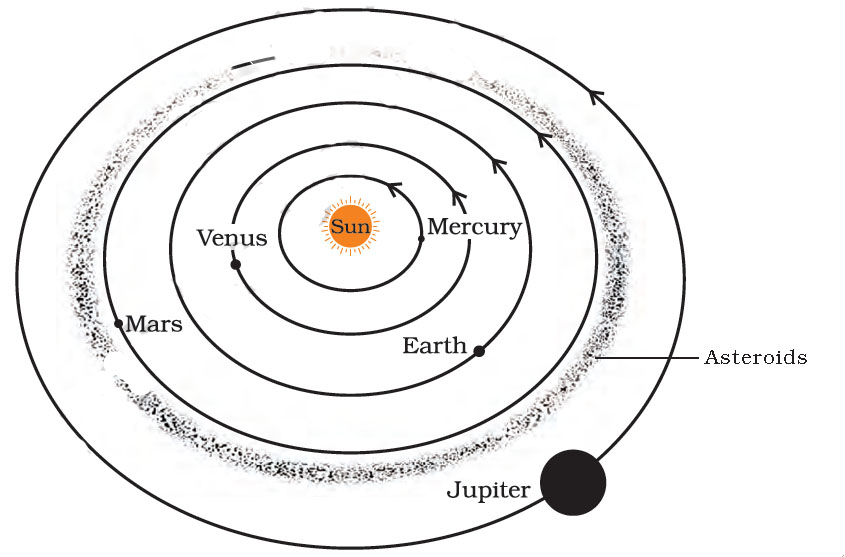The moon is the brightest object in the night sky. The stars, the planets, the moon and many other objects in the sky are called celestial objects. The study of celestial objects and associated phenomena is called astronomy.
The day on which the whole disc of the moon is visible is known as the full moon day. Thereafter, every night the size of the bright part of the moon appears to become thinner and thinner.
On the fifteenth day the moon is not visible. This day is known as the ‘new moon day’ and the next day, only a small portion of the moon appears in the sky. This is known as the crescent moon.
The various shapes of the bright part of the moon as seen during a month are called phases of the moon.
The moon is a fascinating object for poets and story-tellers. But when astronauts landed on the moon, they found that the moon's surface is dusty and barren. There are many craters of different sizes. It also has a large number of steep and high mountains. The moon has no atmosphere. It has no water.
There is a large number of stars in the sky. Observe carefully on a dark night and from a place away from a big city.
In fact, the stars are present in the sky during the day-time also. However, they are not visible then because of the bright sunlight.
The stars forming a group that has a recognisable shape is called a constellation.
One of the most famous constellations which you can see during summer time in the early part of the night is Ursa Major. There are seven prominent stars in this constellation. It appears like a big ladle or a question mark. There are three stars in the handle of the ladle and four in its bowl.
Orion is another well-known constellation that can be seen during winter in the late evenings. It is one of the most magnificent constellations in the sky. It also has seven or eight bright stars, Orion is also called the Hunter. The three middle stars represent the belt of the hunter. The four bright stars appear to be arranged in the form of a quadrilateral.
The star Sirius, which is the brightest star in the sky, is located close to Orion. To locate Sirius, imagine a straight line passing through the three middle stars of Orion. Look along this line towards the east.
Cassiopeia is another prominent constellation in the northern sky. It is visible during winter in the early part of the night. It looks like a distorted letter W or M.
Ursa Major (Saptarshi) Saptarshi has been associated with seven well known ancient Indian sages, or rishis, as shown in the figure below. According to ancient mythology, the seven sages who form the Saptarshi, preserve the eternal knowledge of Vedas and explain it to people in every new age.
The Sun and the celestial bodies which revolve around it form the solar system. It consists of large number of bodies such as planets, comets, asteroids and meteors. The gravitational attraction between the Sun and these objects keeps them revolving around it.
The Earth, as you know, also revolves around the Sun. It is a member of the solar system. It is a planet. There are seven other planets that revolve around the Sun. The eight planets in their order of distance from the Sun are: Mercury, Venus, Earth, Mars, Jupiter, Saturn, Uranus and Neptune.
The Sun
The Sun is the nearest star from us. It is continuously emitting huge amounts of heat and light. The Sun is the source of almost all energy on the Earth. In fact, the Sun is the main source of heat and light for all the planets.
The Planets
A planet has a definite path in which it revolves around the Sun. This path is called an orbit. The time taken by a planet to complete one revolution is called its period of revolution. The period of revolution increases as the distance of the planet increases from the sun.
The Earth can be said to be a satellite of the Sun, though generally we call it a planet of the Sun.
There are many man-made satellites revolving round the Earth. These are called artificial satellites.
There are some other bodies which revolve around the Sun. They are also members of the solar system.
There is a large gap in between the orbits of Mars and Jupiter. This gap is occupied by a large number of small objects that revolve around the Sun. These are called asteroids. Asteroids can only be seen through large telescopes.
Comets are also members of our solar system. They revolve around the Sun in highly elliptical orbits. However, their period of revolution round the Sun is usually very long. A Comet appears generally as a bright head with a long tail. The length of the tail grows in size as it approaches the sun. The tail of a comet is always directed away from the sun.

